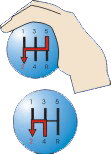Learn to Drive
Driving lesson brief 2. Gears
Introduction
Having mastered moving off in a straight line, you now need to learn how to change gear in order to make progress as you drive along.
Smooth gearing changing is the first of three key foundation skills that you will need to learn. The others being steering and clutch control. These three foundation skills form the basis of most if not all the road, traffic and reversing skills covered in the other parts of the Learner Driving programme.
Therefore before you move onto part 2 of the programme it is vitally important that these three foundation skills become second nature to you – an automatic response requiring little or no conscious thought. This is why the next three lessons are dedicated to the development of these most important skills. Taking the time to concentrate on them at this early stage will dramatically speed up your progress later on. The more effort you put into these foundation skills the easier the remaining road, traffic and reversing skills will be to master.
![]() Lesson objectives
Lesson objectives
By the end of lesson 2 you should be able to:
- Make upward gear changes, in sequence, 1 through to 5
- Make downward gear changes, in sequence, 5 through to 1
- Make upward selective gear changes from 2 to 4 and 3 to 5
- Make downward selective gear changes from 5 to 2, 5 to 3, 5 to 1 , 4 to 2 , 4 to 1 and 3 to 1
- Maintain a straight course and look well ahead whilst changing gear
Subject brief
During this lesson you will learn how to make the car go faster by using the gears to reduce the number of engine revolutions per turn of the wheel. This will allow you to increase the speed of the car but it will reduce its pulling power.

 Gears can be changed up or down. This has nothing to do with the direction that you move the gear lever.
Gears can be changed up or down. This has nothing to do with the direction that you move the gear lever.
 It simply means that you change to a high gear (4 or 5) or a low gear (1 or 2). The basic rule is that you change up through the gears as the speed of the car increases and down when you need more power from the engine. For example, you would change down when climbing a hill or pulling away at low speed.
It simply means that you change to a high gear (4 or 5) or a low gear (1 or 2). The basic rule is that you change up through the gears as the speed of the car increases and down when you need more power from the engine. For example, you would change down when climbing a hill or pulling away at low speed.
 The basic gear changing rule is ‘gears to go - brakes to slow'. As the car increases speed, change up through the gears. When you want to slow down, use the foot brake. You need only change to a lower gear when you need the accelerator again to 'drive' the car along. This means that you may sometimes miss out gears. For example, by changing from fifth or fourth gear to second gear.
The basic gear changing rule is ‘gears to go - brakes to slow'. As the car increases speed, change up through the gears. When you want to slow down, use the foot brake. You need only change to a lower gear when you need the accelerator again to 'drive' the car along. This means that you may sometimes miss out gears. For example, by changing from fifth or fourth gear to second gear.
 This method is called ‘selective’ or ‘block’ gear changing. There are also times when you might selectively change up, having used a lower gear for better acceleration or more pulling power followed by a change to fifth gear when you have reached your intended cruising speed.
This method is called ‘selective’ or ‘block’ gear changing. There are also times when you might selectively change up, having used a lower gear for better acceleration or more pulling power followed by a change to fifth gear when you have reached your intended cruising speed.
Highway code practical references
Rules: 122